

History of Australia Online - Discovery of Gold in Australia. Australia 1851 was notable for the extension of representative Government to all the Australian colonies and for the first gold-field at Bathurst.
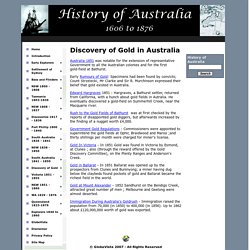
Early Rumours of Gold: Specimens had been found by convicts; Count Strzelecki, Mr Clarke and Sir R. Murchinson expressed their belief that gold existed in Australia. Edward Hargraves 1851 : Hargraves, a Bathurst settler, returned from California, with a hunch about gold fields in Autralia. He eventually discovered a gold-field on Summerhill Creek, near the Macquarie river.
Start.
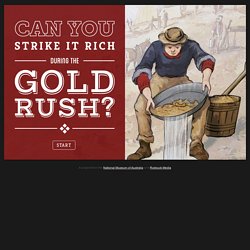
A miner's life: living on the goldfields. Lola Montez Lola Montez was one of the most famous international entertainers to visit the goldfields.
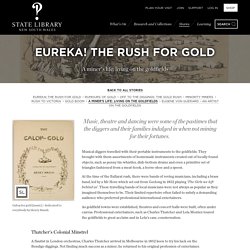
Thought to be of Spanish, Cuban, Indian or Turkish origins, she was born Elizabeth Rosanna Gilbert in 1821 in County Sligo, Ireland. The stage name Lola Montez was adopted after four months' dance tuition and a visit to Spain. She made her stage debut in 1843 where she performed dances during intervals of opera performances. She displayed some talent for dancing, but her beauty and her celebrity were her major successes. By the time she reached Australia in 1855, she had appeared in dramas, burlesques and light comedies in cities such as Dresden, Berlin, Warsaw, St Petersburg, Paris, Munich and San Francisco. Eureka! The rush for gold. Skip to main content Main content area a939008h.jpg.
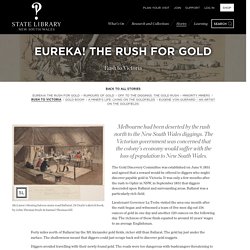
Eureka! The rush for gold. There were around 17,000 Chinese on the goldfields by mid 1855.

Labouring together, the Chinese miners would only work the diggings that had already been worked and deserted by Europeans. Yet they were still accused of taking white men’s claims and were often the scapegoats as disgruntled miners blamed their misfortunes on them. Many of the Chinese miners returned to their families in China, however there were some who stayed, including Quong Tart. He had migrated to Australia, aged nine, with his uncle and moved to the Braidwood goldfields.
Quickly assimilating into the Australian way of life, he developed into a fine cricketer and sportsman, a Freemason and local entrepreneur. Eureka! The rush for gold. The Australian colonies were no longer seen as places of convict exile; they were respectable destinations for immigrants and investment.
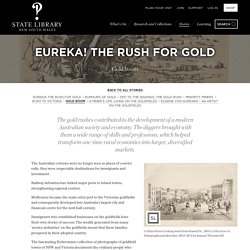
Railway infrastructure linked major ports to inland towns, strengthening regional centres. Melbourne became the main entry port to the Victorian goldfields and consequently developed into Australia’s largest city and financial centre for the next half century. Immigrants who established businesses on the goldfields have their own stories of success. The wealth generated from many 'service industries' on the goldfields meant that these families prospered in their adopted country. Eureka! The rush for gold. The first gold discoverers were shepherds, surveyors and clergymen.
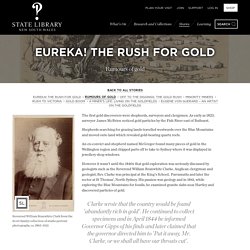
As early as 1823, surveyor James McBrien noticed gold particles by the Fish River east of Bathurst. Shepherds searching for grazing lands travelled westwards over the Blue Mountains and moved onto land which revealed gold-bearing quartz reefs. Manuscripts, oral history & pictures - State Library of New South Wales. Manuscripts, oral history & pictures - State Library of New South Wales. Manuscripts, oral history & pictures - State Library of New South Wales. Description This is a sepia-toned wood engraving made by Frederick Grosse (1828-94) from a sketch by Nicholas Chevalier (1828-1902), and titled 'Emigrants landing at Queen's Wharf Melbourne'.
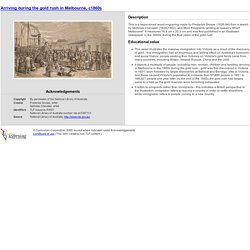
~ GOLD ~ Life on the goldfields was not all work and no play – after sunset, Monday to Saturday, the working day ended and the opportunity for revelry was enthusiastically embraced.
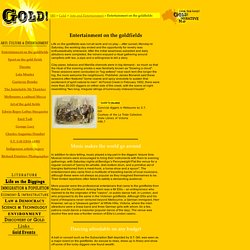
After the initial weariness subsided and daily ablutions were completed, the miners enjoyed a ritual gathering around campfires with tea, a pipe and a willingness to tell a story. Clay pipes, tobacco and Manilla cheroots were in big demand - so much so that the ritual of the evening smoke-o was familiarly known as "blowing a cloud".
These sessions were conducted on "log settees" near each tent (the longer the log, the more welcome the neighbours). Publisher James Bonwick said these sessions often featured "some coarse and spicy anecdote to sustain that excitement of spirit natural to men". State Library of NSW. This portrait of von Guerard was drawn in 1855 by Aboriginal artist Johnny Kangatong.
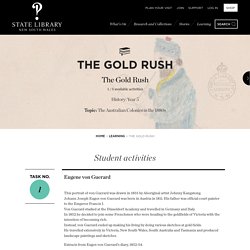
Johann Joseph Eugen von Guerard was born in Austria in 1811. His father was official court painter to the Emperor Francis I. Von Guerard studied at the Düsseldorf Academy and travelled in Germany and Italy. In 1852 he decided to join some Frenchmen who were heading to the goldfields of Victoria with the intention of becoming rich. Instead, von Guerard ended up making his living by doing various sketches at gold fields. Extracts from Eugen von Guerard’s diary, 1852-54. Jan 11. ...left for Eureka [goldfields] this morning, having chartered two bullock wagons to take our belongings... Jan 18 After travelling for a week, we have arrived at Ballarat... Jan 25 Yesterday we went to peg out our claim at Eureka Hill. Jan 27 Having dug to a depth of twenty-four to twenty-five feet...we came upon rock...our only gain being a practice in digging!
RIOT OR REVOLUTION - opening sequence.